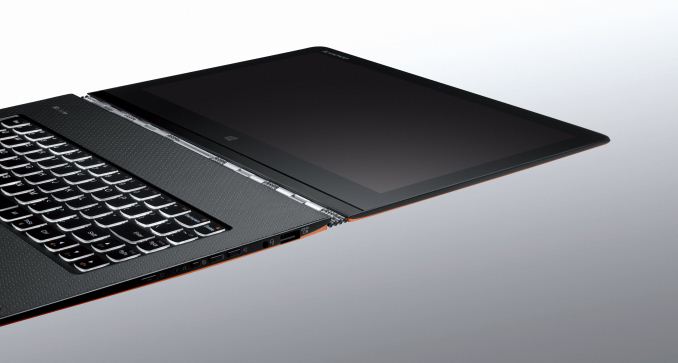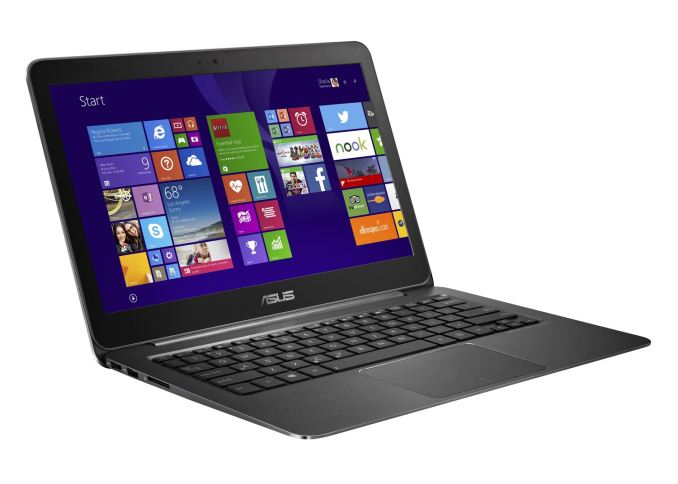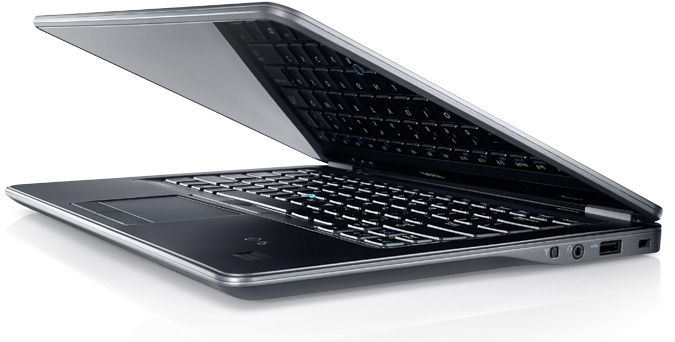Analyzing Intel Core M Performance: How 5Y10 can beat 5Y71 & the OEMs' Dilemma
by Brett Howse & Ian Cutress on April 8, 2015 8:00 AM ESTThe Devices and Test
For today's article we have run a sampling of devices through several benchmarks which vary in workload substantially. Some are single-threaded and some are multi-threaded - some emphasize burst performance, and some focus on sustained performance. Some involve the GPU and some do not. During all of the benchmarks, CPU frequencies, GPU frequencies, and processor temperature were logged. The devices are all different as well, and offer different takes on Core M.
The first device is the Lenovo Yoga 3 Pro. This is the same device that we reviewed, and it features a Core M-5Y71 processor which is the very top of the Core M range. Lenovo has chosen to include a fan, so this is the only one of the Core M devices being included that is actively cooled. Being a convertible laptop, Lenovo must be more wary of surface temperatures than a traditional laptop since the Yoga 3 Pro can be used in the hand as a tablet.
The second device is the ASUS Zenbook UX305, which was recently reviewed as well. This features a Core M-5Y10 processor, which is the lowest-end model available. The UX305 is passively cooled and features an entirely aluminum chassis, which helps to dissipate the heat generated. As a laptop, higher surface temperatures can be manageable since the device is normally sitting on the raised feet and not in direct contact with skin.
The third device is the Dell Venue 11 Pro 7000, which also features the top end Core M-5Y71. This is a tablet first and foremost, and is also passively cooled. The Venue features a plastic rear casing, and as a tablet surface temperatures must be taken into consideration.
The final device is the Dell Latitude 14 7000, which is powered by the Core i5-5200U processor. Being a much higher TDP part, but largely the same architecture, will give a reference point on what Broadwell will do when given better cooling. The sample received has only one channel of memory, which will mostly affect the GPU scores. Dell does offer dual-channel memory, so this device can perform higher than the sample that we have.
Overall the Core i5-5200U is much less dynamic than Core M, with a base CPU frequency of 2.2 GHz and boost of 2.7 GHz. If you will notice, the boost is actually less than the Core M-5Y71, so assuming adequate cooling, or short enough workloads, Core M could in theory outperform the i5, which is something we did see on some benchmarks in the Yoga 3 Pro review.
The average computing day for anyone is going to be wildly different depending on what tasks they are performing. A lot of tasks however are very much burst workloads. As an example, browsing the web means loading the page, which is mostly done upfront. These kinds of workloads will play well into what Core M can do. Boost up to the maximum frequency, get the work done, and then fall back down to the base frequency and cool off. This is the epitome of Intel's hurry up and get idle philosophy.
However not every workload is like this. Gaming for example is a lot of consistent work, done over a long period of time, so cooling is the key here to keep performance up.
To sample a wide variety of workloads, I have picked a variety of benchmarks which are both short and long, do burst work or sustained work, and some involve the GPU and others do not.
Cinebench R15 Single-Threaded: This benchmark performs rendering on a single CPU core, so it should showcase higher clock speeds and good single-threaded performance. The benchmark lasts roughly ten minutes.
Cinebench R15 Multi-Threaded: The same benchmark, but the work is performed on all available cores, including hyper-threading. This benchmark is roughly three minutes.
PCMark 8 Home and Creative: Both the Home and Creative suites of PCMark 8 feature a variety of workloads. Home includes workloads for web browsing, writing, gaming, photo editing, and video chat. Creative includes web browsing, photo editing, video editing, group video chat, media transcoding, and gaming workloads. Home is around thirty minutes, and Creative takes about an hour to complete.
TouchXPRT 2014: This benchmark performs beautify photos (add filters, HDR, etc), blend photos, convert videos for sharing, create music podcast, and create slideshow from photos. Each task is timed, and a lower time results in a higher score. This benchmark takes about ten minutes to finish.
3DMark Sky Diver and Cloud Gate: 3DMark is a staple of our reviews. Both run through several graphics and physics tests which work both the CPU and GPU. Sky Diver is the more difficult of the tests. Sky Diver is about five minutes, and Cloud Gate is about three minutes.
3DMark Ice Storm Unlimited: This test is completely off-screen, and allows for comparison of the graphics across devices and even platforms. Being that it is available for smartphones and tablets, it is a much lower demand on the GPU, and completes very quickly on a PC with the entire benchmark being complete in about a minute.
DOTA 2: This incredibly popular online multiplayer battle-arena game is our final benchmark. This is the same workload performed for the DOTA 2 benchmark we have for reviews, only we run it for the full length of the recording. The entire run is around 45 minutes.
The following pages are very graph heavy, with some of the graphs being quite wide to show the sustained performance of the device over the benchmark run. Below is a gallery of all of the images, in order, which can be references as larger images in a separate window.
A note about the graphs. Each benchmark will show an entire run on each device, and then some combined graphs with the individual scores compared against the other devices. Due to the sampling rate, it may appear that some devices finished the benchmark before the others, but this is not always the case. Several of the devices were too loaded to always log to the text file, so they may have less entries, and appear to get the work done quicker if just comparing based on the time scale. The important data on the combined graphs is how each device handles the entire workload versus the others. We have also included the scores from each device to see where they finish the benchmark.




















110 Comments
View All Comments
OneCosmic833 - Friday, April 10, 2015 - link
I don't really understand, why don't the manufacturers put a little bigger heatsink with a FAN of bigger diameter into these portable devices, is it such a problem??? Production costs reduction or bad engineering? I think it would be also possible to keep the same weight if they cut some bulk mass from somewhere else of the device. Simply this throttling is not acceptable for me and an i7 should not have lower performance than i5 in sustained load...This is very very sad for us consumers, like how the manufacturers skimp us ! ! !metayoshi - Friday, April 10, 2015 - link
Great article!I'm very interested in this, though, after reading the whole article: I noticed the Asus laptop with the metal chassis was the one with the 5Y10, and the two devices that are usable as a tablet/is a tablet are the two devices with the 5Y71. However, I know that the Venue 11 Pro comes with a 5Y10 for its base configuration, so it would be interesting to see how that 5Y10 version compares vs the 5Y71 version, knowing it is thermally handicapped compared to the Lenovo, with its fan, and the Asus, which is a laptop with a metal chassis.
I was originally eyeing the Venue 11 Pro, but I jumped on the preorders of the less powerful but still capable Surface 3 with the new Atom SoC. I'm really intrigued by Core M, but all these stories of throttling and whatnot are keeping me away for now.
serendip - Friday, April 10, 2015 - link
Intel has a decent mobile chip with Atom. Core M, not so much. I would rather have a slower Atom chip that costs a lot less and can turbo for long periods than a Core M with much higher performance that isn't accessible to the user thanks to constant throttling. Maybe there should be a caveat on Core M devices like "2.4 GHz processor (for 10 seconds only), base 1 GHz". That way consumers know what they're really in for.ahfei - Tuesday, April 14, 2015 - link
Is 2.6GHz the maximum turbo speed for M-5Y71 for 2 cores, judging from the graph? Cannot find that info anywhere and some even stated the maximum 2.9GHz is for both cores!Brett Howse - Sunday, April 19, 2015 - link
I have never seen them go over 2.6 GHz for both cores. 2.9 GHz seems to be just for a single core.boe_d - Saturday, April 18, 2015 - link
I like the Sony Vaio Z approach - balls the walls hardware, fast processing power, fast storage, fast video and LIGHT. Still lighter than most laptops 5 years later and faster than many of them too! Battery power wasn't great but it had an easy to replace battery.RanBuch - Saturday, July 18, 2015 - link
I own a Lenovo yoga 3 pro. Can I configure the SoC temperature from 65°C to a higher value? I use the device as a "desktop" more often then a tablet and would love to get more juice from my machine even at the expense of the device "overheating" a little bit.HP - Wednesday, August 5, 2015 - link
These processors are perfectly decent. But at the same time, really novel due to the fact that no active cooling is required to run them. This in my view is a positive progression in CPUs together with the SoC philosophy. To have everything integrated into a smaller space. Many users might complain about performance but I bet they don't use their i5 or i7 machines to the fullest potential either. Core-M performance is perfectly decent. Granted, the only slow downs I have experienced is when compiling a Linux kernel say or running multiple FHD videos. But such tasks are run on a less than regular basis so a slight slow down in speed during these exercises is acceptable. The rest of the tasks get carried out very well in a thin, light and quiet design.Atreyiu - Tuesday, February 2, 2016 - link
I know many will disagree with me, but I am a regular user and I hate when my Venue 11 Pro 7140 (5Y10, 64 Gb, 04 Gb RAM) is heated so much that I can not put my right hand in it, that temperature is unbearable from 55 ° C upwards. Should not rise beyond what your skin can handle. This happens pretty and very quickly, then to lower spend enough time. I'm thinking let go of it and look for an alternative. I wanted a balanced team between productivity and way of life, but these temperature rises disenchanted me and the only thing that bothers me because it is fast and has no crashes or anything like that.SandraGok - Tuesday, June 9, 2020 - link
I'm not just inviting you! But it will be interesting for sure loveawake.ru